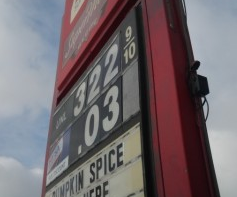Despite the destruction superstorm Sandy inflicted on the East Coast, car owners across the U.S. have seen benefits at the gas pumps.
According to the U.S. Energy Information Administration, national gas prices have fallen 20 cents over the past two weeks. Minnesota residents saw an even greater drop as prices plummeted 60 cents between the first week of October and the first week of November.
Senior Bri Velzke said as a commuter, the gas prices have made a big difference for her.

“I live 20 miles away and it really justifies my commute,” Velzke said. “I chose to live 20 miles away because there were cheaper housing options, and the lower gas prices have made it worth it.”
John Hofmeister, former CEO of Shell Oil Co., said superstorm Sandy’s location and season were responsible for the storm’s effect in the gas industry.
In an interview with NBC’s “Today,” Hofmeister said the drop in prices is predominantly a matter of timing.
He said prices usually drop during the winter season due to less driving, but that the consistent weak state of the economy has driven prices so high that demand has fallen, pushing prices down even lower.
Hofmeister also said Sandy’s landfall in the northeast left little impact on the oil industry because of its location. He said 25 percent of oil refineries are located in the Gulf of Mexico, and the size and destruction caused by Category 5 Hurricane Katrina crippled the oil industry more than superstorm Sandy could.
Economics professor Jim Vincent agreed with Hofmeister. Vincent said the location played a key role in the decline of gas prices.
“Had the storm fallen on the Gulf, we would have seen major rises in prices. So many of our resources are located there,” Vincent said. “Instead, we might have seen the opposite reaction. It’s more likely that the demand for oil fell after the storm, lowering the prices.”
Junior Brittany Baumgarten said she did not see Sandy having much of an effect on gas prices in Minnesota, but she appreciates the lower prices nationwide.
“I figure that the prices in New York and other places hit by the storm would shoot up, but I think that the seasonal trend had more to do with it across the nation,” Baumgarten said. “I have a car on-campus, and I find myself driving less.”
Baumgarten said that although she is driving less in the winter, she appreciates the ease on her wallet when she fills up her tank.
“I wish we could see prices like this year-round, but I’ll take the prices that we have now. It’s much better than what I was paying to drive this summer,” Baumgarten said.
Like Baumgarten, sophomore Jennifer McHattie said she finds herself driving less in the winter, but she was surprised that the storm did not cause a jump in prices.
“I know that prices rose after Hurricane Katrina hit Louisiana, but I can see why prices would fall,” McHattie said. “Personally, I feel like prices would rise especially in the East, but I don’t mind that they are this low.”
Anastasia Straley can be reached at stra0669@stthomas.edu.

